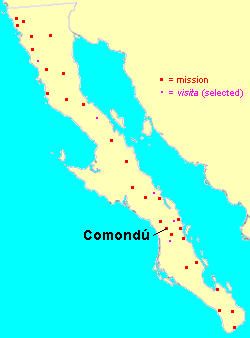Misión San José de Comondú
- View a machine-translated version of the Spanish article.
- Machine translation, like DeepL or Google Translate, is a useful starting point for translations, but translators must revise errors as necessary and confirm that the translation is accurate, rather than simply copy-pasting machine-translated text into the English Wikipedia.
- Consider adding a topic to this template: there are already 929 articles in the main category, and specifying
|topic=will aid in categorization. - Do not translate text that appears unreliable or low-quality. If possible, verify the text with references provided in the foreign-language article.
- You must provide copyright attribution in the edit summary accompanying your translation by providing an interlanguage link to the source of your translation. A model attribution edit summary is
Content in this edit is translated from the existing Spanish Wikipedia article at [[:es:Misión de San José de Comondú]]; see its history for attribution. - You may also add the template
{{Translated|es|Misión de San José de Comondú}}to the talk page. - For more guidance, see Wikipedia:Translation.

Mission San José de Comondú was one of the Jesuit missions established early in the 18th century in Baja California Sur, Mexico, west of Loreto on an arroyo flowing to the Pacific coast. Over the course of its existence, the mission was twice relocated.
Etymology
The mission was named after Saint Joseph and the indigenous Cochimí settlement of Comondú.
History
"Comondú Viejo" was established in 1709 by the missionary Julián de Mayorga and financed by the Marqués de Villapuente de la Peña and his wife the Marquesa de las Torres de Rada. The location proved less than ideal as an agricultural settlement. A smallpox epidemic in 1710 killed half of the mission's neophytes. The mission was moved to its second site in 1736, and Comondú Viejo became a visita or subordinate mission station. The foundations of the chapel and portions of an irrigation system survive.
The new location for Comondú was located about 50 kilometers to the southwest, at what had previously been the visita of San Miguel. This location was reduced back to visita status in 1737, although many structural remnants of the mission survive.
The final location for the mission was about 3 kilometers upstream from San Miguel. First adobe structures and, after 1750, a large stone building were erected. However, the neophyte population declined from more than 300 in 1740 to 80 in 1768 and 28 in 1800. The mission ceased to function in 1827. Substantial architectural remnants survived into the 20th century, but the existing buildings have been extensively renovated.
Destruction
It is told a governor ordered the mission's remains demolished using dynamite in 1930 in order to use the consequent stone from the ruins, in order to build a school. It is remarkable, given stone abounds in the region.
See also
- Missions in Baja California Sur
- List of Jesuit sites
References
- Vernon, Edward W. 2002. Las Misiones Antiguas: The Spanish Missions of Baja California, 1683–1855. Viejo Press, Santa Barbara, California.
- v
- t
- e
- Misión San Bruno (1683)
- Misión de Nuestra Señora de Loreto Conchó (1697)
- Visita de San Juan Bautista Londó (1699)
- Misión San Francisco Javier de Viggé-Biaundó (1699)
- Misión San Juan Bautista Malibat (Misión Liguí) (1705)
- Misión Santa Rosalía de Mulegé (1705)
- Misión San José de Comondú (1708)
- Misión La Purísima Concepción de Cadegomó (1720)
- Misión de Nuestra Señora del Pilar de La Paz Airapí (1720)
- Misión Nuestra Señora de Guadalupe de Huasinapi (1720)
- Misión Santiago de Los Coras (1721)
- Misión Nuestra Señora de los Dolores del Sur Chillá (1721)
- Misión San Ignacio Kadakaamán (1728)
- Misión Estero de las Palmas de San José del Cabo Añuití (1730)
- Misión Santa Rosa de las Palmas (Misión Todos Santos) (1733)
- Misión San Luis Gonzaga Chiriyaqui (1740)
- Misión Santa Gertrudis (1752)
- Misión San Francisco Borja (1762)
- Visita de Calamajué (1766)
- Misión Santa María de los Ángeles (1767)
- Misión San Fernando Rey de España de Velicatá (1769)
- Visita de la Presentación (1769)
- Misión Nuestra Señora del Santísimo Rosario de Viñacado (1774)
- Visita de San José de Magdalena (1774)
- Misión Santo Domingo de la Frontera (1775)
- Misión San Vicente Ferrer (1780)
- Misión San Miguel Arcángel de la Frontera (1797)
- Misión Santo Tomás de Aquino (1791)
- Misión San Pedro Mártir de Verona (1794)
- Misión Santa Catarina Virgen y Mártir (1797)
- Visita de San Telmo (1798)
- Misión El Descanso (Misión San Miguel la Nueva) (1817)
- Misión de Nuestra Señora de Guadalupe del Norte (1834)
 Catholicism portal
Catholicism portal
 | This New Spain-related article is a stub. You can help Wikipedia by expanding it. |
- v
- t
- e














